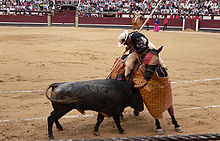Caparison

A caparison is a cloth covering laid over a horse or other animal for protection and decoration. In modern times, they are used mainly in parades and for historical reenactments. A similar term is horse-trapper.[1] The word is derived from the Latin caparo, meaning a cape.[2]
Horses

In the Middle Ages, caparisons were part of the horse armour known as barding, which was worn during battle and tournaments. They were adopted in the twelfth century in response to conditions of campaigning in the Crusades, where local armies employed archers, both on foot and horse, in large quantities. The covering might not completely protect the horse against the arrows but it could deflect and lessen their damage. An early depiction of a knight's horse wearing a caparison may be seen on the small Carlton-in-Lindrick knight figurine from the late 12th century. Modern re-enactment tests have shown that a loose caparison protects the horse reasonably well against arrows, especially if combined with a gambeson-like undercloth underneath. Medieval caparisons were frequently embroidered with the coat of arms of the horse's rider.
Domesticated and temple elephants of India


In the Indian state of Kerala, elephants are decorated during temple festivals. They wear a distinctive golden head covering called a nettipattam, which is often translated into English as an elephant caparison. However, it covers only the head, not the body, as in a horse caparison.
See also
References
- ^ Trapper sold at Christie's
- ^ "caparison (n.)". Online Etymology Dictionary. Retrieved April 2015.
{{cite web}}: Check date values in:|accessdate=(help)
External links
- Caparisons in 13th–17th century illustrations and artwork
- A caparison made for the wedding-celebration of Gustaf II Adolf of Sweden and Maria Eleonora of Brandenburg, 1621
- Caparisons in the 14th-century German Manesse Codex
![]() This article incorporates text from a publication now in the public domain: Chambers, Ephraim, ed. (1728). Cyclopædia, or an Universal Dictionary of Arts and Sciences (1st ed.). James and John Knapton, et al.
This article incorporates text from a publication now in the public domain: Chambers, Ephraim, ed. (1728). Cyclopædia, or an Universal Dictionary of Arts and Sciences (1st ed.). James and John Knapton, et al. {{cite encyclopedia}}: Missing or empty |title= (help)
